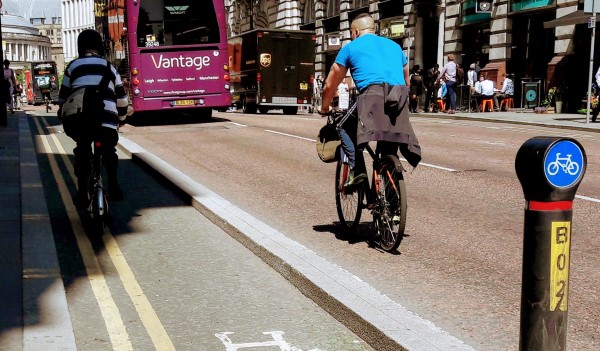Manchester cyclists need to update our skills. So do developers.
 As someone who commutes into Manchester by bike, I’ve largely escaped the horror experienced by train commuters this week. My journey has remained reliable and I’ve escaped delays, cancellations and crowded trains with my nose pressed into someone’s sweaty armpit.
As someone who commutes into Manchester by bike, I’ve largely escaped the horror experienced by train commuters this week. My journey has remained reliable and I’ve escaped delays, cancellations and crowded trains with my nose pressed into someone’s sweaty armpit.
All is not perfect in the world of commuter cycling though. Three times this week I’ve had to break sharply to avoid an accident. Two of those near misses were caused by other cyclists.
Oxford Road corridor
The cycle improvements along the Oxford Road corridor have been a great success. Far more people cycle now then a couple of years ago, and cycling feels safer and more pleasant. Some are hardened bikers in lycra. Increasing numbers are dressed in normal clothes and potter in and out, either on their own transport or on a Mobike.
But the success has brought problems of its own. Both the times I narrowly avoided colliding with a fellow cyclist this week, it was someone turning right without signalling. There were no cars or pedestrians who needed to see that signal, but I did.
A couple of years ago it wouldn’t have been a problem. Fewer cyclists, no cycle-only junctions. Today it is a problem. It’s perfectly normal now to be in a group of five to ten cyclists close together, with the faster ones looking to overtake the slowcoaches where it’s safe to do so. Today, cyclists need to know if others are about to turn.
So as we work towards creating a City Centre that’s less jammed and less polluted, by getting more people out of cars and onto bikes, we all have to adjust.
Car drivers have to be more aware of cyclists and cycle paths, as do pedestrians. The more cyclists there are on the roads, the more natural that becomes. And of course there are further improvements needed to make life better for cyclists and pedestrians: the Made to Move strategy takes aim at those.
Cyclists need to up our game…
But we cyclists need to improve and update our skills and behaviour too:
- Obey the rules of the road. Yes, some of us do stop at red lights – quite a lot of us in fact! We also need to give way to pedestrians at zebra crossings (including those little ones across the cycle paths to bus stops), if we expect them to give way to us elsewhere.
- Signal to other cyclists. If I’m cycling right behind you, I need to know that you’re about to turn left or right. My psychic powers are sadly not good enough to figure this out on my own.
- Be polite. Yes, some people are complete idiots, but this stuff is pretty new in the UK and we’re all learning. Swearing at pedestrians and drivers who make a genuine mistake isn’t going to help us turn Greater Manchester into a Cycling City.
Oh, and my third near-miss of the week? A grey Jaguar who didn’t feel the need to even indicate as he cut me up, turning left into Mauldeth Road and narrowly missing a collision that could easily have left me in hospital. We’ve all got lessons to learn.
…and developers do too
For our clients at BECG, transport infrastructure is an essential part of any new development. That includes catering for pedestrians and cyclists as well as motor vehicles and public transport. It includes travel plans, sustainable travel and thinking about the environment and pollution, not just getting from A to B. If we are going to build towns and cities for people, we need to enable changes in our behaviour, not just our environment.
BECG is the only communications agency specialising in the built environment. Get in touch for a chat about how we can help you.
Selected industry experts bring you insight and expert advice, across a range of sectors.
Subscribe for free to receive our fortnightly round-up of property tips and expertise
Selected industry experts bring you insight and expert advice, across a range of sectors.
Subscribe for free to receive our fortnightly round-up of property tips and expertise





